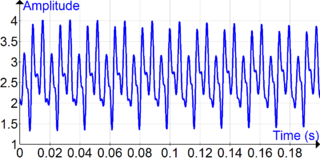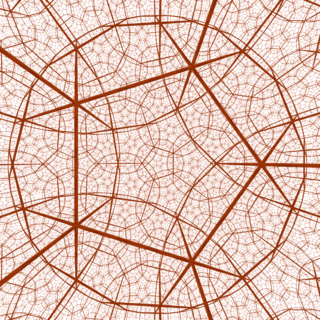
In mathematics, a field is a set on which addition, subtraction, multiplication, and division are defined and behave as the corresponding operations on rational and real numbers do. A field is thus a fundamental algebraic structure which is widely used in algebra, number theory, and many other areas of mathematics.

In mathematics, Fourier analysis is the study of the way general functions may be represented or approximated by sums of simpler trigonometric functions. Fourier analysis grew from the study of Fourier series, and is named after Joseph Fourier, who showed that representing a function as a sum of trigonometric functions greatly simplifies the study of heat transfer.
In mathematics, a product is the result of multiplication, or an expression that identifies objects to be multiplied, called factors. For example, 21 is the product of 3 and 7, and Failed to parse : x\cdot (2+x) is the product of and . When one factor is an integer, the product is called a multiple.

In mathematics, a sequence is an enumerated collection of objects in which repetitions are allowed and order matters. Like a set, it contains members. The number of elements is called the length of the sequence. Unlike a set, the same elements can appear multiple times at different positions in a sequence, and unlike a set, the order does matter. Formally, a sequence can be defined as a function from natural numbers to the elements at each position. The notion of a sequence can be generalized to an indexed family, defined as a function from an arbitrary index set.
In mathematics, a field K is called a (non-Archimedean) local field if it is complete with respect to a topology induced by a discrete valuation v and if its residue field k is finite. Equivalently, a local field is a locally compact topological field with respect to a non-discrete topology. Sometimes, real numbers R, and the complex numbers C are also defined to be local fields; this is the convention we will adopt below. Given a local field, the valuation defined on it can be of either of two types, each one corresponds to one of the two basic types of local fields: those in which the valuation is Archimedean and those in which it is not. In the first case, one calls the local field an Archimedean local field, in the second case, one calls it a non-Archimedean local field. Local fields arise naturally in number theory as completions of global fields.
In mathematics, class field theory (CFT) is the fundamental branch of algebraic number theory whose goal is to describe all the abelian Galois extensions of local and global fields using objects associated to the ground field.
In mathematics, local class field theory, introduced by Helmut Hasse, is the study of abelian extensions of local fields; here, "local field" means a field which is complete with respect to an absolute value or a discrete valuation with a finite residue field: hence every local field is isomorphic (as a topological field) to the real numbers R, the complex numbers C, a finite extension of the p-adic numbersQp (where p is any prime number), or the field of formal Laurent series Fq((T)) over a finite field Fq.
In mathematics, subgroup growth is a branch of group theory, dealing with quantitative questions about subgroups of a given group.

In mathematics, a hyperbolic manifold is a space where every point looks locally like hyperbolic space of some dimension. They are especially studied in dimensions 2 and 3, where they are called hyperbolic surfaces and hyperbolic 3-manifolds, respectively. In these dimensions, they are important because most manifolds can be made into a hyperbolic manifold by a homeomorphism. This is a consequence of the uniformization theorem for surfaces and the geometrization theorem for 3-manifolds proved by Perelman.
In mathematics, a pro-p group is a profinite group such that for any open normal subgroup the quotient group is a p-group. Note that, as profinite groups are compact, the open subgroups are exactly the closed subgroups of finite index, so that the discrete quotient group is always finite.
In mathematics, an automatic group is a finitely generated group equipped with several finite-state automata. These automata represent the Cayley graph of the group. That is, they can tell if a given word representation of a group element is in a "canonical form" and can tell if two elements given in canonical words differ by a generator.
In the theory of algebraic groups, a Cartan subgroup of a connected linear algebraic group over a field is the centralizer of a maximal torus. Cartan subgroups are smooth, connected and nilpotent. If is algebraically closed, they are all conjugate to each other.
In mathematics, a Drinfeld module is roughly a special kind of module over a ring of functions on a curve over a finite field, generalizing the Carlitz module. Loosely speaking, they provide a function field analogue of complex multiplication theory. A shtuka is a sort of generalization of a Drinfeld module, consisting roughly of a vector bundle over a curve, together with some extra structure identifying a "Frobenius twist" of the bundle with a "modification" of it.
In applied mathematics, Gabor atoms, or Gabor functions, are functions used in the analysis proposed by Dennis Gabor in 1946 in which a family of functions is built from translations and modulations of a generating function.

Daniel Segal is a British mathematician and a Professor of Mathematics at the University of Oxford. He specialises in algebra and group theory.

In Lie theory and related areas of mathematics, a lattice in a locally compact group is a discrete subgroup with the property that the quotient space has finite invariant measure. In the special case of subgroups of Rn, this amounts to the usual geometric notion of a lattice as a periodic subset of points, and both the algebraic structure of lattices and the geometry of the space of all lattices are relatively well understood.

Aner Shalev is a professor at the Einstein Institute of Mathematics at the Hebrew University of Jerusalem, and a writer.
In mathematics, a Tate vector space is a vector space obtained from finite-dimensional vector spaces in a way that makes it possible to extend concepts such as dimension and determinant to an infinite-dimensional situation. Tate spaces were introduced by Alexander Beilinson, Boris Feigin, and Barry Mazur (1991), who named them after John Tate.
In algebraic geometry, given a linear algebraic group G over a field k, a distribution on it is a linear functional satisfying some support condition. A convolution of distributions is again a distribution and thus they form the Hopf algebra on G, denoted by Dist(G), which contains the Lie algebra Lie(G) associated to G. Over a field of characteristic zero, Cartier's theorem says that Dist(G) is isomorphic to the universal enveloping algebra of the Lie algebra of G and thus the construction gives no new information. In the positive characteristic case, the algebra can be used as a substitute for the Lie group–Lie algebra correspondence and its variant for algebraic groups in the characteristic zero ; for example, this approach taken in (Jantzen 1987).

Eamonn Anthony O'Brien is a professor of mathematics at the University of Auckland, New Zealand, known for his work in computational group theory and p-groups.










